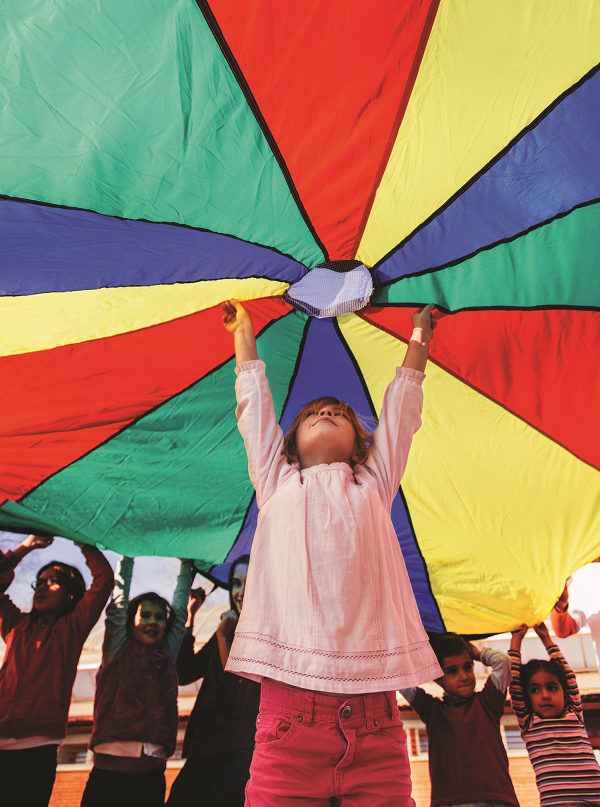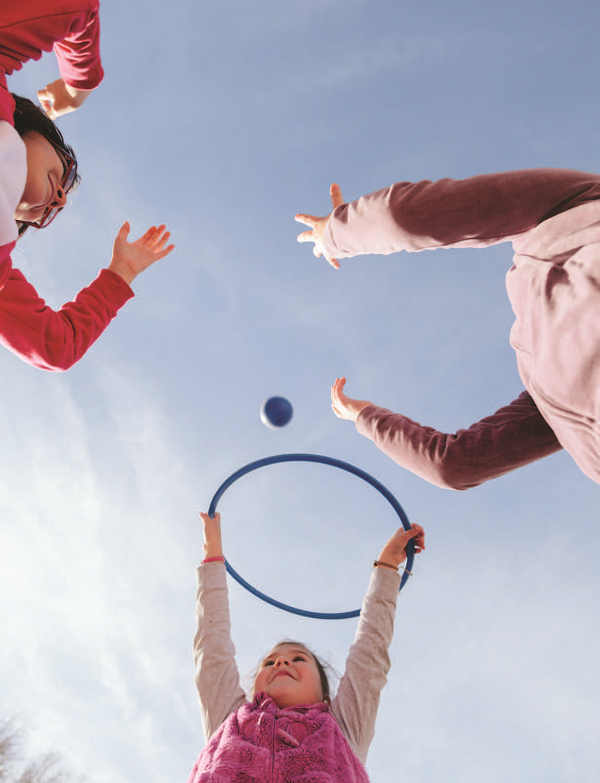Let PE Teachers Play a Leading Role
When it comes to social-emotional learning instruction, don’t overlook the PE teacher as the one to take charge.
When it comes to social-emotional learning instruction, don’t overlook the PE teacher as the one to take charge.
By Joel DiBartolomeo
Principal, March/April 2017
 Every organization has those go-to individuals who convey an infectious, energizing quality. They are approachable and have a positive effect on the environment around them.
Every organization has those go-to individuals who convey an infectious, energizing quality. They are approachable and have a positive effect on the environment around them.
In schools, these individuals typically work well with large groups of students, know everyone in the school community, have a vested interest in the school culture, and are trusted and well-regarded for their efforts and outcomes. My experience has shown that physical education teachers are uniquely suited for this role, given the nature of their position and their knack for interpersonal dynamics.
With this in mind, school leaders must find a way to invest in the PE teacher’s development as a teacher leader, and then use that role as the nexus for disseminating information, coordinating initiatives, and constructing programs. The PE teacher at our school is trusted to steward schoolwide initiatives—especially those founded on social-emotional learning (SEL)—facilitate team building, and preside over student participation programs.
Creating the Vision
As a newly appointed principal in 2010, my primary goals were to learn how the school’s systems operated and find out how the culture and student performance at this once high-performing school had eroded with such abruptness. My 13-year career as a secondary math teacher and content coach, in addition to my four years as a middle school assistant principal, helped prepare me for the theory and operations I would encounter in an elementary building. Nevertheless, I felt like Crusoe in the K-5 world of education.
My first year began with excited caution and eagerness to build a strong community of learners who would work with common understanding toward a shared vision and short list of goals. Our vision would be founded upon SEL (and behavior expectations) and would be implemented in every classroom, modeled by every adult, and connected to every person and place in our school community.
The vision included a schoolwide behavior plan, a school delegation, a mentor program, and student partnerships or “buddies.” The school leadership team responsible for overseeing this initiative comprised teachers from across the school, and at the center of this group was our health and PE teacher, Mr. K.
SEL in Action
 Our team believed the SEL program should be introduced in physical education class, so PE became the petri dish for program experimentation, trials, and coordination. Because Mr. K already knew and worked with each student and was in contact with all teachers twice a week, his informal interactions were ideal for communicating student observations and performance. We began by examining our school’s PE schedule, which at the time included 16 individual 60-minute classes of students in grades 1-5. We changed the PE format from one 60-minute class each week to two 30-minute classes twice each week. This change provided the necessary time in Mr. K’s schedule for him to preside over our student partnership programs.
Our team believed the SEL program should be introduced in physical education class, so PE became the petri dish for program experimentation, trials, and coordination. Because Mr. K already knew and worked with each student and was in contact with all teachers twice a week, his informal interactions were ideal for communicating student observations and performance. We began by examining our school’s PE schedule, which at the time included 16 individual 60-minute classes of students in grades 1-5. We changed the PE format from one 60-minute class each week to two 30-minute classes twice each week. This change provided the necessary time in Mr. K’s schedule for him to preside over our student partnership programs.
Mr. K took the lead in teaching students about the program’s goals and protocols in his PE class. He introduced the behavior plan and expectations for all interactions and resolution of conflicts. He began by engaging students in various types of games that could easily be played during the 25-minute recess time. Soon after introducing recess games in PE class, Mr. K visited each grade level during recess to build the program and model expectations.
Mr. K also drafted a set of “house rules” for each game. Directions and expectations were written on 3×5 notecards in an attempt to minimize ongoing conflict about how to play. The plan worked. Conflict during recess was decreased dramatically and students learned to resolve problems independently. To support the PE/recess component of the school’s SEL program, Mr. K organized assemblies where he and a team of educators explained, modeled, and coordinated assorted games for students, faculty, and families.
Student Partnership Programs
Once the school community understood and accepted the shared vision and schoolwide behavior plan, Mr. K developed the school’s mentor program for students who needed an additional outlet and more individualized opportunities. Students in this program meet once a week and collaborate on project-based learning and teambuilding activities, such as visits to the local senior center where they interact with senior citizens and various community members. All activities also serve as leadership opportunities for students and a chance to apply the character-development skills learned through the mentor program.
Candidates are identified for this program using various qualitative and classroom performance information. More weight is given to a student’s social-emotional qualities when determining a need. Classroom teachers or any member of the school will make a student referral when the student is observed to have challenging social interactions, the behaviors interfere with learning and relationships, and/or the child is not involved in our school community. The referral is sent to our Child Study Team (CST), whose members consider all available student information to determine needs. The CST then recommends placement and contacts the family using a standard letter, which is really an invitation to participate.
Once a candidate is identified for the mentor program, the mentor teacher team, which includes Mr. K and the school counselor, considers the student’s survey and interview information for an appropriate partner or cross-grade peer. With proper planning and some good fortune, this peer also becomes the mentee’s reading buddy. The importance of this student partnership, reading buddy or not, is vital to the success of both students involved, so the match requires careful consideration of all information collection from across the school.
Our Reading Buddies program offers students the opportunity to develop social-emotional skills and collaborate with peers on reading, writing, and project-based learning activities, which are connected to our SEL vision and goals. The program partners students in different grade levels once a month: fifth graders with first graders, fourth graders with second graders, and third graders with our kindergarten students.
Program Results
We continue to host assemblies every two to three years to maintain awareness and support for our program and the initiatives it promotes. Evidence suggests a correlation between this program and a sharp decline in student conflicts that were historically connected to recess games.
Our students have many options and opportunities available for play during recess, but now know how to manage conflict peacefully. Our recess monitors have become coaches and discussion facilitators rather than referees and authoritarians. Much of the interaction that often led to vitriol between students and recess monitors has disappeared.
At all school functions, Mr. K is visible and adored by our families for his involvement and efforts to promote a physically and emotionally healthy lifestyle. His work with each student in our building in the most unstructured settings is vital to our understanding of the whole child.
He will often have his mentor students in the gym shooting hoops, jumping rope, or engaged in some activity to prime blood flow, release energy, or simply decompress. He has given our students outlets they wouldn’t have had if not for his willingness to work so collaboratively with his colleagues. These interventions for students in need of these types of supports have become a hallmark for our school and a preferred program of families.
A Valuable Resource
A school’s PE teacher plays a valuable role and can serve as a resource beyond their classroom. The connections they make with students are different from those formed by other classroom teachers. With some creative thinking about the schedule and use of time, the PE teacher can provide natural learning opportunities that will not arise in even the most dynamic classrooms.
Because we live in a society where competition and measurement are valued and promoted, we must teach our students proper and ethical ways of behaving, along with the responsibilities that come with competition. Our school’s behavior plan spells out expectations, character traits, and attitude, but SEL must be permitted to happen in real time. Who better to deliver this message in a safe and natural way than our PE teachers?
Program implementation cannot be duplicated, but the conditions to create the model can, and these are driven by the resources and needs of the classroom, building, or district. Here are a few tips to get started in your own school environment:
- Develop a volunteer committee of teachers and parents to review existing programs, conduct research, and identify and prioritize important outcomes.
- Identify tools to survey students and measure growth.
- Select activities and community partnerships in which the students would engage.
- Work collaboratively with faculty to develop common understandings and modify the existing schedule.
- Align the program to the school’s behavior or SEL program so that its connections across the school are deep and consistent.
- Review the program monthly to discuss progress, suggestions, and effectiveness.
Our school has recently been awarded two grants and received the national Best Practices Award from Character.org for these programs and the outcomes they have produced.
Joel DiBartolomeo is principal of Chestnutwold Elementary School in Ardmore, Pennsylvania.
Copyright © National Association of Elementary School Principals. No part of the articles in NAESP magazines, newsletters, or website may be reproduced in any medium without the permission of the National Association of Elementary School Principals. For more information, view NAESP’s reprint policy.

